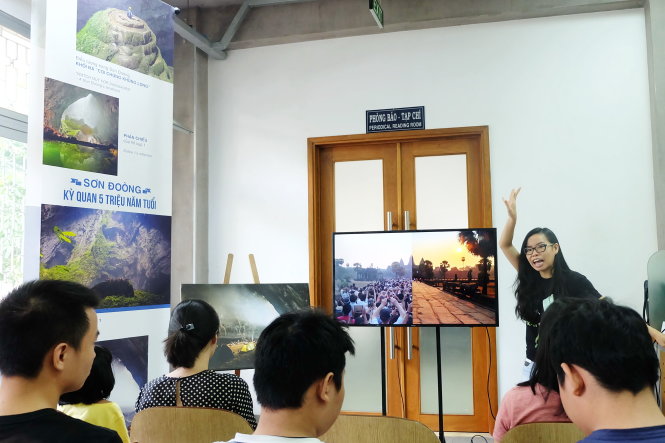One of the founders of “Save Son Doong," an online movement to oppose any efforts of commercializing the eponymous cave system in north-central Vietnam, has decided to adopt virtual reality (VR) to save one of the world's most stunning natural wonders.
Son Doong is one of the world’s most stunning caves believed to be around five million years old, but it has only recently been found by British cave expert Howard Limbert.
The finding of the beautiful cave system was quickly followed by government and investor plans to commercially exploit the site mainly through tourism.
The “Save Son Doong” Facebook page was founded four years ago as a movement to oppose any efforts of commercializing the place.
Virtual tour
Among the founders, Le Nguyen Thien Huong is one of the most vocal Vietnamese opposing the commercialization of the beautiful cave.
Having conquered many different caves of different sizes, the young Vietnamese is also known as a ‘cave girl’.
Huong said for her, Son Doong is not just a cave, but a whole world that needs to be protected and preserved.
While those behind “Save Son Doong” do not agree to make the cave accessible to the public, they acknowledge that everyone deserves to experience its beauty.
Launching a VR tour through Son Doong has emerged as the solution, as the technology allows users to see the magnificence of the cave without having to access it.
In one of the virtual Son Doong tours on the weekend in Ho Chi Minh City, there were almost 8,000 registrations to experience the cave.
Each participant will have VR glasses put on as Huong stands in the corner of the room to present about the cave, as well as its unique biological features and vulnerabilities, a reason why it needs to be preserved.
Love for Son Doong
In 2014, Huong was lucky enough to have a chance to explore the cave first-hand, as well as an opportunity to meet with Howard Limbert.
“During that time, rumors about cable car construction in Son Doong were spreading,” Huong recalled.
“[Limbert] was worried that Son Doong will be destroyed if it is exploited for mainstream tourism, since only a touch on its limestone rocks can cause a change in formation because of our sweat and viruses on the hands.”
Huong was the only Vietnamese in the group and acknowledging the destruction public tourism can cause, she was determined to do her best to protect and preserve the natural landscape.
In July 2014, she started writing letters and petitions to authorities and preservation centers.
After she read about a plan to build a cable car system through the cave, she went on to write a long Facebook post explaining the cave’s biological and geographical features so as to indicate the vulnerability of its uniqueness and need for preservation.
During that time, she and her colleagues at “Save Son Doong” started holding events where participants could experience the cave through new virtual reality technology while explaining both value and how much damage could be made if too many people went into the cave.
Many people doubted Huong’s efforts as they posed questions such as why she would be doing this, what good it would do, or what change it would make.
“The more people raised their voices, the more investors doubted,” Huong said.
“A survey in Tuoi Tre [Youth] newspaper also showed that 90 percent of the respondents opposed the cable car development.”
Even though many doubted her efforts, they eventually paid off.
The strong opposition and negative reaction from the public forced investors to make changes to the project, so instead of going straight into the cave, the cable car system now stops 3.5 kilometers before reaching the cave.
Whole new ecosystem
When Huong started the “Save Son Doong” campaign, she thought about establishing a museum for Vietnam’s natural wonders before they are changed, damaged, or destroyed.
Her desire is to record these beautiful scenery as lively as possible so that even people who do not have the chance to visit the most famous tourist destinations in Vietnam including Ha Long Bay, Son Doong, or Thien Duong (Paradise) Cave will still experience their breathtaking beauty.
With disabled people in mind, she talked about how her virtual tours to Son Doong would benefit people with special needs including autistic children, the physically impaired or hearing-impaired.
“Without the cable car, these people will not have a chance to see natural wonders like Son Doong, which is a great loss,” said the young activist.
That is also the reason why she always prioritizes tickets to her virtual Son Doong tours for people with special needs and the elderly.
Once, a girl with asthenopia burst into tears when she saw Son Doong for the first time through the VR glasses.
She said she wished to see Son Doong through her own eyes at least once before she loses her eyesight forever.
However, according to Huong, this is highly impossible as the girl’s eyesight is quickly getting worse.
Huong strongly believes Son Doong is a new world that still needs to be explored.
In the United States, there is a cave that has been completely closed down to the public because the scientists found out the cave contains viruses that may be a remedy for cancer, according to Huong.
“Son Doong is a completely separated world. It is not just a beautiful, great, and mysterious cave for people to admire and explore, but there is also a whole ecosystem that humans have not been able to study yet. Hence, it is ever more important for it to be protected from destruction,” she said.
Like us on Facebook or follow us on Twitter to get the latest news about Vietnam!

















































